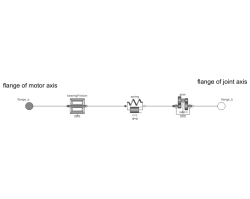GearType1Motor inertia and gearbox model for r3 joints 1,2,3 |
|
Diagram
Information
This information is part of the Modelica Standard Library maintained by the Modelica Association.
Models the gearbox used in the first three joints with all its effects, like elasticity and friction. Coulomb friction is approximated by a friction element acting at the "motor"-side. In reality, bearing friction should be also incorporated at the driven side of the gearbox. However, this would require considerable more effort for the measurement of the friction parameters. Default values for all parameters are given for joint 1. Model relativeStates is used to define the relative angle and relative angular velocity across the spring (=gear elasticity) as state variables. The reason is, that a default initial value of zero of these states makes always sense. If the absolute angle and the absolute angular velocity of model Jmotor would be used as states, and the load angle (= joint angle of robot) is NOT zero, one has always to ensure that the initial values of the motor angle and of the joint angle are modified correspondingly. Otherwise, the spring has an unrealistic deflection at initial time. Since relative quantities are used as state variables, this simplifies the definition of initial values considerably.
Parameters (6)
| i |
Value: -105 Type: Real Description: Gear ratio |
|---|---|
| c |
Value: 43 Type: Real (N·m/rad) Description: Spring constant |
| d |
Value: 0.005 Type: Real (N·m·s/rad) Description: Damper constant |
| Rv0 |
Value: 0.4 Type: Torque (N·m) Description: Viscous friction torque at zero velocity |
| Rv1 |
Value: 0.13 / 160 Type: Real (N·m·s/rad) Description: Viscous friction coefficient (R=Rv0+Rv1*abs(qd)) |
| peak |
Value: 1 Type: Real Description: Maximum static friction torque is peak*Rv0 (peak >= 1) |
Connectors (2)
Components (3)
| gear |
Type: IdealGear |
|
|---|---|---|
| spring |
Type: SpringDamper |
|
| bearingFriction |
Type: BearingFriction |
